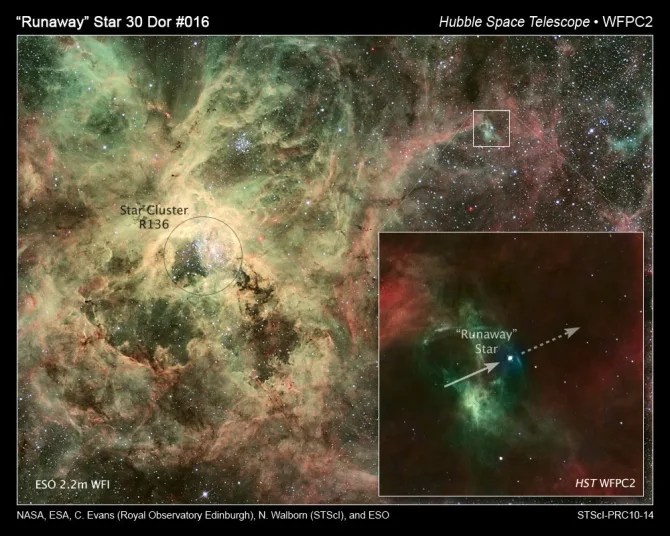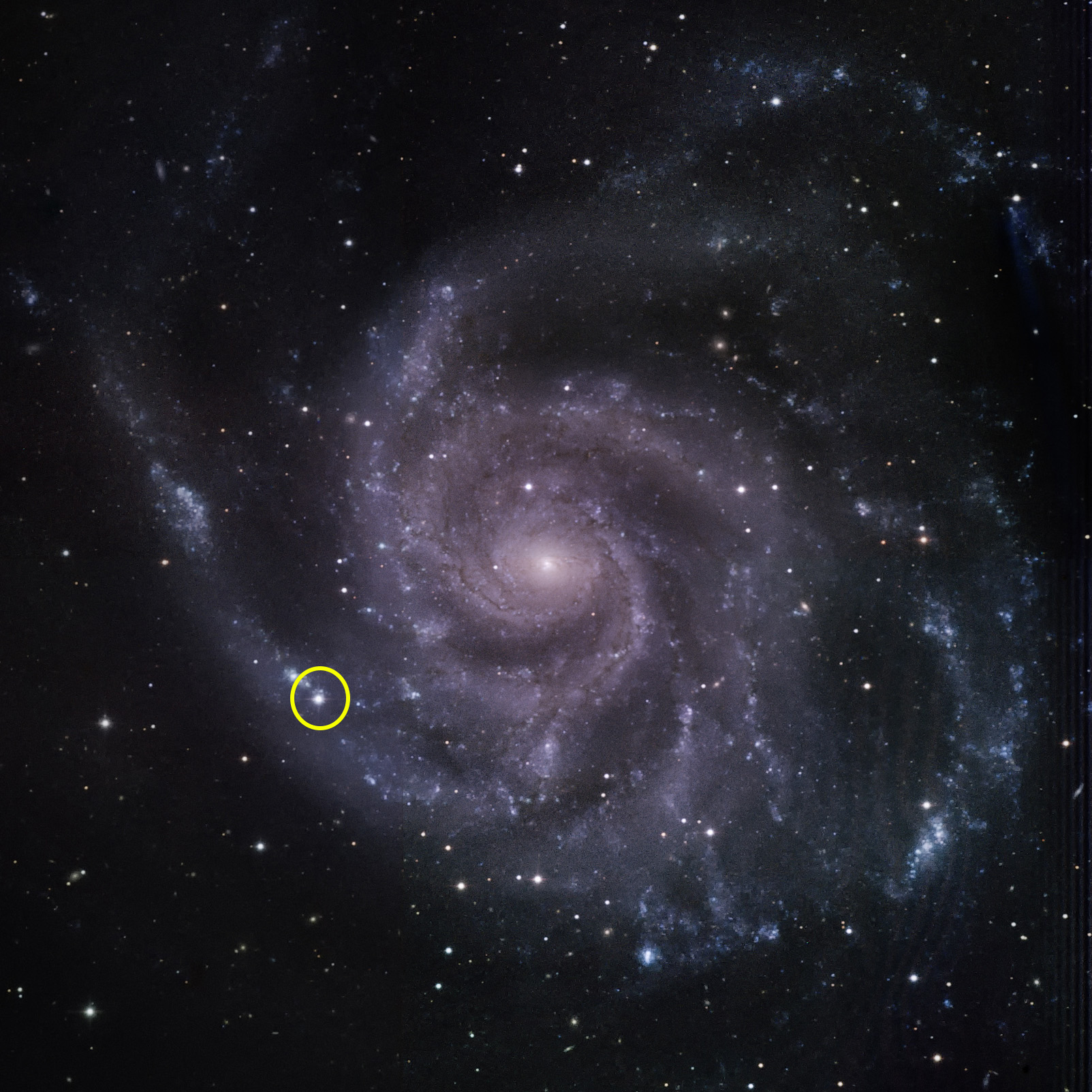6 min read

This image of the 30 Doradus nebula, a rambunctious stellar nursery, and the enlarged inset photo show a heavyweight star that may have been kicked out of its home by a pair of heftier siblings. In the inset image at right, an arrow points to the stellar runaway and a dashed arrow to its presumed direction of motion. The image was taken by the Wide Field and Planetary Camera 2 (WFPC2) aboard NASA's Hubble Space Telescope. The heavyweight star, called 30 Dor #016, is 90 times more massive than the Sun and is traveling at more than 250,000 miles an hour. In the wider view of 30 Doradus, the homeless star, located on the outskirts of the nebula, is centered within a white box. The box shows Hubble's field of view. The image was taken by the European Southern Observatory's (ESO) Wide Field Imager at the 2.2-meter telescope on La Silla, Chile. The young star, only 1 million to 2 million years old, may have traveled about 375 light-years from its suspected home in R136, the bright star cluster marked by a circle. Credit for Hubble Image: NASA, ESA, J. Walsh (ST-ECF), and ESO Acknowledgment: Processing by Z. Levay (STScI) Credit for wide-field Image: ESO Acknowledgement: J. Alves (Calar Alto, Spain), and B. Vandame and Y. Beletski (ESO). Processing by B. Fosbury (ST-ECF)
› Larger image
A heavy runaway star is rushing away from a nearby stellar nursery at more than 250,000 miles an hour, a speed that will get you to the Moon and back in two hours. The runaway is the most extreme case of a very massive star that has been kicked out of its home by a group of even heftier siblings.
The homeless star is on the outskirts of the 30 Doradus nebula, a raucous stellar breeding ground in the nearby Large Magellanic Cloud. The finding bolsters evidence that the most massive stars in the local universe reside in 30 Doradus, making it a unique laboratory for studying heavyweight stars. Also called the Tarantula Nebula, 30 Doradus is roughly 170,000 light-years from Earth.
Tantalizing clues from three observatories, including the Hubble Space Telescope's newly installed Cosmic Origins Spectrograph (COS), and some old- fashioned detective work, suggest that the star may have traveled about 375 light-years from its suspected home, a giant star cluster called R136. Nestled in the core of 30 Doradus, R136 contains several stars topping 100 solar masses each.
The observations offer insights into how massive star clusters behave.
"These results are of great interest because such dynamical processes in very dense, massive clusters have been predicted theoretically for some time, but this is the first direct observation of the process in such a region," says Nolan Walborn of the Space Telescope Science Institute in Baltimore and a member of the COS team that observed the misfit star. "Less massive runaway stars from the much smaller Orion Nebula Cluster were first found over half a century ago, but this is the first potential confirmation of more recent predictions applying to the most massive young clusters."
Runaway stars can be made in a couple of ways. A star may encounter one or two heavier siblings in a massive, dense cluster and get booted out through a stellar game of pinball. Or, a star may get a 'kick' from a supernova explosion in a binary system, with the more massive star exploding first.
"It is generally accepted, however, that R136 is sufficiently young, 1 million to 2 million years old, that the cluster's most massive stars have not yet exploded as supernovae," says COS team member Danny Lennon of the Space Telescope Science Institute. "This implies that the star must have been ejected through dynamical interaction."
The runaway star research team, led by Chris Evans of the Royal Observatory Edinburgh, published the study's results May 5 in the online edition of The Astrophysical Journal Letters.
Astronomers have been on the trail of this rogue star since 2006 when a team led by Ian Howarth of University College London spotted it with the Anglo-Australian Telescope at Siding Spring Observatory. The observation revealed that the stellar misfit was an exceptionally hot, massive, blue-white star and relatively far from any cluster in which such stars are usually found.
Hubble astronomers unexpectedly picked up another clue when they used the star as a target to calibrate the COS instrument, installed in May 2009 during Servicing Mission 4. Those ultraviolet spectroscopic observations, made in July 2009, showed that the wayward star is unleashing a fury of charged particles in one of the most powerful stellar winds known, a clear sign that it is extremely massive, perhaps as much as 90 times heavier than the Sun. The star, therefore, also must be very young, about 1 million to 2 million years old, because extremely massive stars live only a few million years.
Sifting through Hubble's archive of images, astronomers found another important piece of evidence. An optical image of the star taken by the Wide Field Planetary Camera 2 in 1995 revealed that it is at one end of an egg-shaped cavity. The cavity's glowing edges stretch behind the star and point in the direction of its home in 30 Doradus.
Another spectroscopic study from the European Southern Observatory's Very Large Telescope (VLT) at the Paranal Observatory in Chile revealed that the star's velocity is constant and not a result of orbital motion in a binary system. Its velocity corresponds to an unusual motion relative to the star's surroundings: evidence that it is a runaway star.
The study also confirmed that the light from the runaway is from a single massive star rather than the combined light of two lower-mass stars. In addition, the observation established that the star is about 10 times hotter than the Sun, a temperature that is consistent with a high-mass object.
The VLT observations are part of a legacy program called the FLAMES (VLT multi- object spectrograph) Tarantula Survey. The survey, conducted by an international team led by Evans of the Royal Observatory, comprises more than 900 stars in the 30 Doradus region. Like the COS observations of the star, the FLAMES results also were serendipitous. The star's location is far from the nebula's central region, placing it at the edge of the FLAMES survey field.
The renegade star may not be the only runaway in the region. Two other extremely hot, massive stars have been spotted beyond the edges of 30 Doradus. Astronomers suspect that these stars, too, may have been ejected from their home. They plan to analyze the stars in detail to determine whether 30 Doradus might be unleashing a barrage of massive stellar runaways into the surrounding neighborhood.
The wayward star will continue to streak across space, says team member Paul Crowther of the University of Sheffield in England, and will eventually end its life in a titanic supernova explosion, likely leaving behind a remnant black hole.







